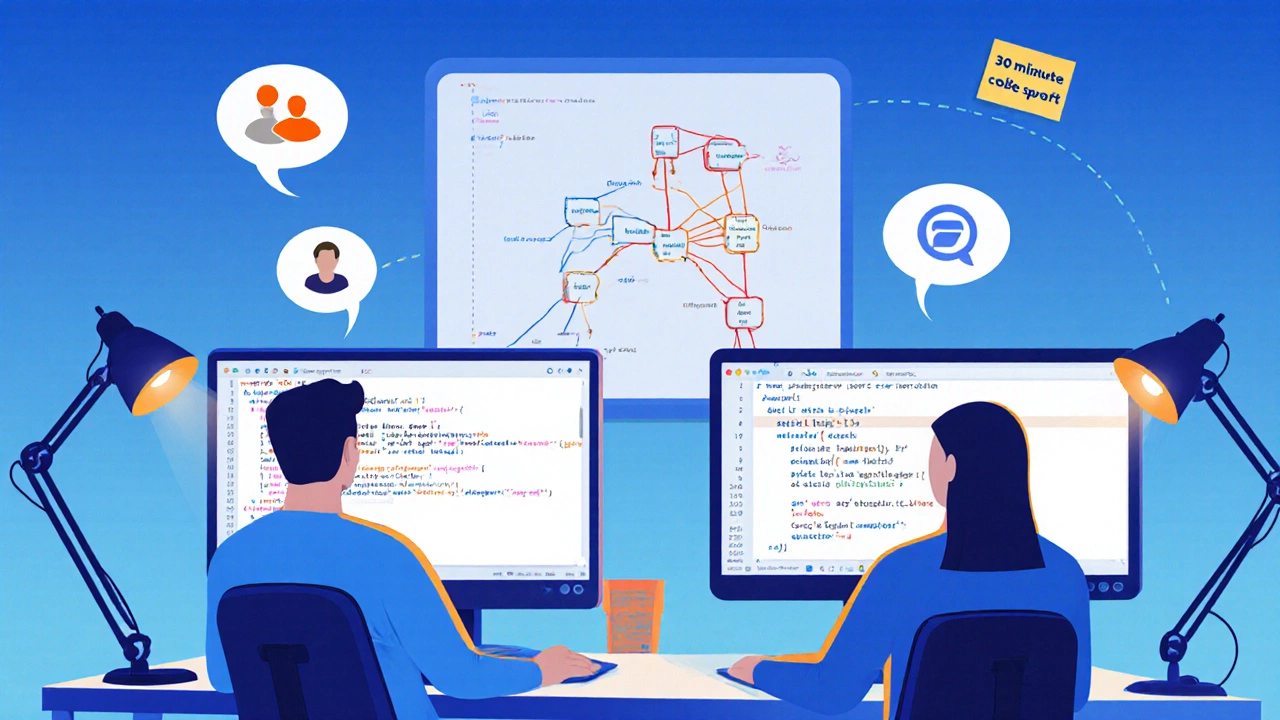Oct
12

- by Dhruv Ainsley
- 0 Comments
Coding Learning Curve Simulator
Understand Your Coding Journey
This simulator visualizes how your practice habits affect your learning curve. See how consistent daily practice creates the 'aha' moment when coding becomes easier.
Your Practice Settings
How this works: The learning curve shows three phases: initial rapid growth (first month), plateau (when concepts get harder), then exponential improvement when skills click together. Your settings affect the speed of the curve.
Your Learning Journey
Your consistent practice is building foundational skills. At this stage, you're developing the mental models needed to tackle more complex problems.
Key milestones:
- Week 0-4 Basic syntax mastery - You're learning variables, loops, and conditionals.
- Week 5-8 Plateau phase - Concepts like recursion and data structures start feeling challenging.
- Week 9-16 Breakthrough point - Skills start clicking together and coding becomes easier.
Most people ask themselves, Does coding ever get easier? The short answer is yes, but the path isn’t always obvious. When you first sit down at a keyboard, the symbols look like a foreign language and the problems seem impossible. Over weeks and months, however, many developers report that the same tasks that once felt painful become almost instinctual. This article explains why that shift happens and gives you concrete steps to speed it up.
Key Takeaways
- Early frustration is normal - it stems from unfamiliar mental models.
- Growth follows a learning‑curve pattern: rapid early gains, a plateau, then exponential improvement.
- Break problems into tiny, testable pieces and use tools like an IDE or debugger.
- Pick resources that match your style - project‑based, mentor‑guided, or structured courses.
- Consistent habits, community support, and version‑control practice keep momentum going.
Why Coding Feels Hard at First
coding is a process of writing instructions that a computer can execute. The brain must translate abstract ideas into concrete syntax, which is a double mental load. A programming language a set of rules and symbols used to communicate with computers adds another layer of specificity - each language has its own quirks, punctuation, and idioms. When you throw algorithms step‑by‑step procedures for solving problems into the mix, you’re dealing with logic that often requires you to think several moves ahead.
Research on novice programmers shows that the biggest barrier is not lack of intelligence but the need to build new neural pathways. The first weeks involve a lot of syntax‑error hunting, which can be discouraging. Recognizing that this is a normal part of the learning curve helps you stay patient.
The Learning Curve Is Not Linear
Most learners experience a steep rise in confidence during the first month - you master basics like variables, loops, and simple conditionals. Then, a plateau often appears. During this phase, you’re tackling data structures, recursion, and more abstract concepts. The brain is rewiring, so progress feels slow.
After the plateau, many report an "aha" moment where previously opaque topics click, and the speed of learning accelerates dramatically. This is because you now have a toolbox of patterns and mental models you can reuse. The curve can be visualized as a shallow rise, a flat spot, then a sharp upward slope.

Practical Strategies to Make Coding Easier
Below are proven tactics that shrink the learning curve.
- Start with pseudocode. Write the logic in plain English before translating it into actual code. This separates thinking from syntax.
- Use an IDE software that combines code editor, compiler, and debugger features. Features like autocomplete, linting, and inline error highlighting prevent small mistakes from snowballing.
- Leverage a debugger tool that lets you step through code line by line. Instead of guessing why something fails, you can watch variable values in real time.
- Read official documentation authoritative reference material for a language or library early and often. Treat it as a map, not a textbook.
- Join a community group of developers who share knowledge and help each other. Stack Overflow, Discord servers, or local meetups provide quick answers and moral support.
Choosing the Right Learning Path
Not every method works for every person. Below is a quick comparison of three popular approaches.
| Approach | Time Investment per Week | Concept Depth | Motivation Factor |
|---|---|---|---|
| Project‑Based | 5-10hours | High - applies concepts immediately | Very high - you see a tangible product |
| Structured Course | 3-6hours | Medium - guided progression | Moderate - keeps you on schedule |
| Mentor/Pair Programming | 2-4hours | Very high - real‑time feedback | High - accountability and social learning |
Pick the approach that aligns with your schedule and learning style. If you thrive on seeing results, project‑based work will make coding feel easier faster.
Habits That Accelerate Mastery
Consistent daily practice trumps occasional marathon sessions. Here are habit‑forming tips:
- Code for at least 30 minutes every day. Short, focused sessions build muscle memory.
- Use version control system like Git to track changes and experiment safely. Seeing your progress over time is motivating.
- Pair with a peer at least once a week. Pair programming a collaborative coding technique where two developers work together exposes you to different problem‑solving methods.
- Review and refactor old code. Revisiting earlier projects shows how far you’ve come and reinforces best practices.
- Apply spaced repetition for theory - flashcards for syntax rules, data‑structure properties, or algorithm complexities.

Common Pitfalls and How to Dodge Them
Even experienced developers fall into traps that make coding feel harder again.
- Premature optimization. Trying to write the most efficient code before you understand the problem leads to confusion. First get it working, then improve.
- Copy‑pasting without comprehension. It may compile, but you won’t learn the underlying concepts.
- Skipping testing. Small unit tests catch bugs early and give you confidence to experiment.
- Relying on a single resource. Diversify with docs, tutorials, and community answers to get multiple perspectives.
- Neglecting fundamentals. Data structures, algorithmic thinking, and basic syntax are the foundation for any language.
Measuring Progress and Staying Motivated
Set clear, achievable milestones. For example, aim to build a simple to‑do list app in two weeks, then a personal website in a month. Use a public portfolio (GitHub) to showcase work - the visual proof of improvement fuels confidence.
Track metrics such as:
- Number of completed coding challenges per week.
- Time taken to debug a typical error.
- Frequency of committing code to version control.
When you see numbers moving in the right direction, the mental barrier lowers, and coding becomes easier in a very tangible way.
Frequently Asked Questions
Will I ever stop feeling stuck when learning to code?
Feeling stuck is a natural part of learning any complex skill. The key is to recognize the plateau, apply targeted strategies like breaking problems into smaller pieces, and keep a consistent practice schedule. Over time the frequency and duration of stuck periods shrink dramatically.
Is it better to learn multiple programming languages at once?
For most beginners, focusing on one language first builds a solid mental model of core concepts. Once you’re comfortable, picking up another language becomes easier because the underlying algorithms and data structures transfer.
How much time should I spend on practice each day?
Consistency beats intensity. Even 30 minutes a day creates strong muscle memory. If you can commit more, aim for 1-2 hours, but avoid long, irregular sessions that lead to burnout.
What role does community play in making coding easier?
A supportive community provides quick answers, code reviews, and encouragement. Engaging with peers accelerates learning because you encounter diverse solutions and get feedback that corrects misconceptions early.
Should I use a debugger right away?
Yes. Learning to step through code early demystifies bugs. Modern IDEs make debugging easy, and the habit pays off as your projects become more complex.





